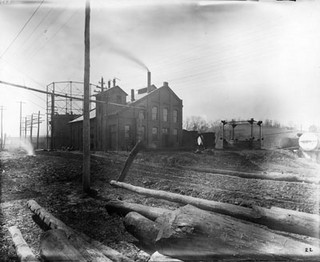Natural Gas
 Natural gas is an odorless, colorless mixture composed largely of methane that became in the twentieth century one of North Carolina's most important energy sources. The U.S. Department of Energy lists North Carolina as one of the states with no producing natural gas wells, and no proved underground reserves. The Southwest, primarily Texas and Louisiana, including the Gulf of Mexico, holds vast reserves. By 1900 natural gas had been discovered in 17 states, but without means of transportation, its use was limited. When found with oil or coal, the gas was often simply vented.
Natural gas is an odorless, colorless mixture composed largely of methane that became in the twentieth century one of North Carolina's most important energy sources. The U.S. Department of Energy lists North Carolina as one of the states with no producing natural gas wells, and no proved underground reserves. The Southwest, primarily Texas and Louisiana, including the Gulf of Mexico, holds vast reserves. By 1900 natural gas had been discovered in 17 states, but without means of transportation, its use was limited. When found with oil or coal, the gas was often simply vented.
Some North Carolina cities acquired manufactured gas in the 1850s. Organization of the Wilmington Gas Light Company in 1854 brought gas streetlights to that city. Charlotte added gas streetlights in 1858, and that same year the Raleigh Gas Light Company lit the capital's streets. Gas fixtures went into buildings under construction, such as the Dorothea Dix Hospital. In January 1859 the General Assembly voted to install gas lights in the executive mansion.
In 1949 the Transcontinental Gas Pipeline Company (Transco) began constructing a 1,832-mile pipeline from production and storage fields in Texas to New York City. The pipeline ran through Piedmont North Carolina. When operation began in early 1951, vast quantities of natural gas became available for utilities to offer customers. In 1998 the Transco pipeline carried 957,525 million cubic feet of natural gas into North Carolina. Including 5,019 million cubic feet supplied from Virginia, a total of 240,980 million cubic feet went to North Carolina companies and families for power production, heating, cooling, cooking, and water heating. As a source of primary energy, natural gas ranked fourth in North Carolina, after petroleum, coal, and nuclear fuel. The state's average price for natural gas was higher than the national average, since all supplies were imported.
By the early 2000s, eight of the state's cities maintained a municipal gas system. Large distributors in the state included Duke Energy; Piedmont Natural Gas; Public Service Company of North Carolina, incorporated in 1938 and later a part of Scana Corporation; North Carolina Natural Gas Corporation, a subsidiary of Progress Energy;NUI-North Carolina Gas Service Division; and Frontier Utilities of North Carolina, Inc.
Additional Resources:
Asheville, NC, gas plant, no date (probably c.1910's - 1920's). From CP&L Collection, PhC.68, North Carolina State Archives, call #: PhC68_1_12. Available from https://www.flickr.com/photos/north-carolina-state-archives/4820854273/ (accessed October 15, 2012).
1 January 2006 | McGee, Barry